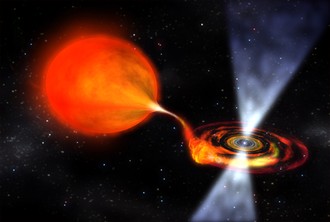
Millisecond pulsars are very fast rotating (over one hundred revolutions per second) neutron stars – a very dense and compact objects of solar masses and 10 km sizes. Not all pulsars are rotating so fast. Only a few, those in binary systems could be speed up by accretion of matter from a companion. During this process magnetic field of a neutron star is decreasing by four orders of magnitude and it’s mas is growing. Michał Bejger, Paweł Haensel, Leszek Zdunik of the Copernicus Astronomical Center and Morgane Fortin of Meudon Observatory studied millisecond pulsar formation process. The resukts are in a paper „Formation of millisecond pulsars - NS initial mass and EOS constraints”. Taking into account evolution of the system (stellar type and mass of the companion star) and relativistic effects in the thin accretion disk authors estimate the original neutron star mass. Studying millisecond pulsars formation processes are relevant for understanding the birth of neutron stars in supernovae explosions and neutron stars mass function.
The picture is an artistic vision of Terzan 5 ad - the most rapidly spinning pulsar known, with a spin frequency of 716 Hz. Credit: NASA.






